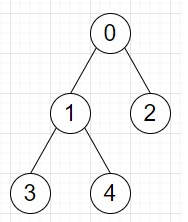
 Data Structure
Data Structure Networking
Networking RDBMS
RDBMS Operating System
Operating System Java
Java MS Excel
MS Excel iOS
iOS HTML
HTML CSS
CSS Android
Android Python
Python C Programming
C Programming C++
C++ C#
C# MongoDB
MongoDB MySQL
MySQL Javascript
Javascript PHP
PHP
- Selected Reading
- UPSC IAS Exams Notes
- Developer's Best Practices
- Questions and Answers
- Effective Resume Writing
- HR Interview Questions
- Computer Glossary
- Who is Who
Program to count number of unique paths that includes given edges in Python
Suppose we have a list of edges in the form (u, v) and these are representing a tree. For each edge we have to find the total number of unique paths that includes said edge, in the same order as given in the input.
So, if the input is like edges = [[0, 1],[0, 2],[1, 3],[1, 4]]

then the output will be [6, 4, 4, 4].
To solve this, we will follow these steps −
adj := adjacency list from given edges
count := an empty map
Define a function dfs() . This will take x, parent
count[x] := 1
-
for each nb in adj[x], do
-
if nb is same as parent, then
come out from the loop
count[x] := count[x] + dfs(nb, x)
-
return count[x]
From the main method do the following −
dfs(0, -1)
ans := a new list
-
for each edge (a, b) in edges, do
x := minimum of count[a] and count[b]
insert (x *(count[0] - x)) at the end of ans
return ans
Example
Let us see the following implementation to get better understanding −
from collections import defaultdict class Solution: def solve(self, edges): adj = defaultdict(list) for a, b in edges: adj[a].append(b) adj[b].append(a) count = defaultdict(int) def dfs(x, parent): count[x] = 1 for nb in adj[x]: if nb == parent: continue count[x] += dfs(nb, x) return count[x] dfs(0, -1) ans = [] for a, b in edges: x = min(count[a], count[b]) ans.append(x * (count[0] - x)) return ans ob = Solution() edges = [ [0, 1], [0, 2], [1, 3], [1, 4] ] print(ob.solve(edges))
Input
[ [0, 1], [0, 2], [1, 3], [1, 4] ]
Output
[6, 4, 4, 4]

